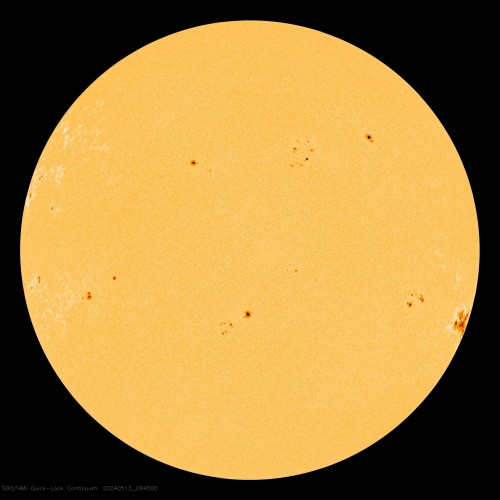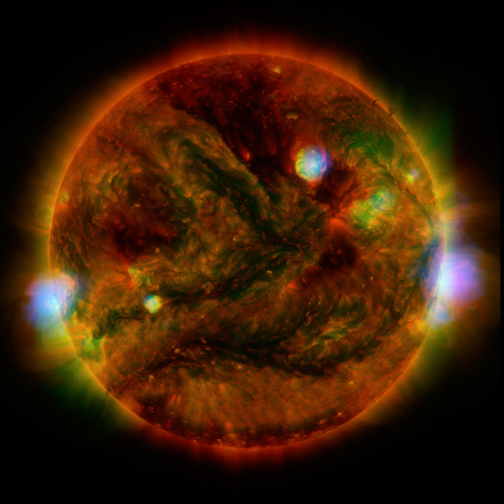Predikce sluneční a geomagnetické aktivity
Solar activity forecast for the period |
April 19 - April 25, 2024 |
| Activity level: | mostly low to moderate |
| X-ray background flux (1.0-8.0 A): | in the range B5.2 - C4.5 |
| Radio flux (10.7 cm): | a fluctuation in the range 119-258 |
| Events: | class C (2-8/day), class M (0-8/period), class X (0-1/period), proton (0/period) |
| Relative sunspot number (Ri): | in the range 80-250 |
Vlastislav Feik
RWC Prague, Astronomical Institute, Solar Dept., Ondrejov, Czech Republic
e-mail: sunwatch(at)asu.cas.cz
Geomagnetic activity forecast for the period |
April 19 - April 25, 2024 |
| Quiet: | Apr 20, 22 - 24 |
| Unsettled: | Apr 19, 20 - 22 |
| Active: | possible Apr 21, 25 |
| Minor storm: | possible about Apr 21, 25 |
| Major storm: | 0 |
| Severe storm: | 0 |
| Geomagnetic activity summary: |
Last week, the geomagnetic activity peaked locally at April 16. At Budkov observarory, we recorded double K-index at level 5 (6 pm till 9 pm UTC). Since this event, we expect geomagnetic activity decrease to unsettled level. |
Tomas Bayer, RWC Prague
Institute of Geophysics of the ASCR, Prague
Department of Geomagnetism
Budkov observatory (BDV)
Geomagnetic activity forecast for the period |
April 19 - April 25, 2024 |
Geomagnetic field will be:
| Quiet on: | |
| Quiet to unsettled on: | |
| Quiet to active on: | |
| Unsettled to active on: | |
| Active to disturbed: |
|
| Solar wind will intensify on: |
|
Remarks:
Weekly Commentary on the Sun, the Magnetosphere, and the Earth's Ionosphere April 19 - April 25, 2024
Weekly Commentary on the Sun, the Magnetosphere, and the Earth's Ionosphere – April 18, 2024
Over the past weekend, active sunspot regions began to emerge on the eastern limb as expected. Curiosity about what we would actually see was heightened because their flare activity during the last rotation was somewhat higher than usual. Therefore, the CME from a moderate eruption in the northern hemisphere of the Sun on April 11 with a maximum at 1706 UT was not a surprise. The arrival of the particle cloud on April 14 was therefore expected, but it missed the Earth.
Another CME was ejected towards Earth on 12 April. Although neither CME was particularly strong, a G1 class geomagnetic storm was expected. This occurred on 16 April, so either the particle cloud moved more slowly or travelled along a longer path towards the Earth. Either way, the disturbance worsened shortwave propagation conditions on April 16. But their improvement was rapid, starting as early as April 17. The credit for this goes to the increasing solar radiation coming from the active regions we can observe on the Sun this week and next.
Another weak CME left the Sun on April 15, and the Earth's impact was calculated for April 18. However, all predictions of disturbances at the current stage of the 11-year cycle are unreliable. They are usually either late (by a day or so) or not at all. The important thing is the result - due to the relatively high solar activity and at the same time the small number of geomagnetic disturbances, the shootwave prpagation conditions are mostly above average.
Poznámka:
Informace jsou přebírány z uvedených externích zdrojů a z důvodů přesnosti jsou zveřejňovány výhradně v anglickém jazyce.
Připravované akce
Přednáška "Zpráva o zatmění Slunce 21. srpna"
16. 10. 2017, 19:00 hodin, Zlín
Vyhledávání
Novinky a aktuality
Částečné zatmění Slunce
12.10.22
Částečné zatmění Slunce nastane 25. října 2022 Začátek astronomického úkazu (první kontakt) v 11:14:58 SELČ Hvězdárna bude pro veřejnost otevřena od 11:00 do 14:00 hodiny.
Odešel dlouholetý pozorovatel Slunce
16.02.22
Dne 11. února 2022 nás navždy opustil ve věku 73 let náš kamarád a kolega pan František Zloch, dlouholetý aktivní pozorovatel projevů sluneční aktivity na Astronomickém ústavu AV ČR v Ondřejově a popularizátor nejen astronomie.
Jaký je sluneční cyklus č. 25?
10.02.22
Již dva roky (od prosince 2019) je v činnosti sluneční cyklus s pořadovým číslem 25. Jak to vypadá po srovnání lednových údajů s počty slunečních skvrn a co nás může čekat v budoucnu?











